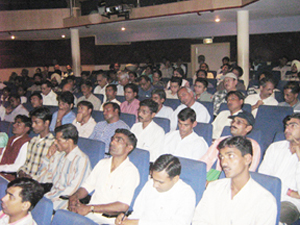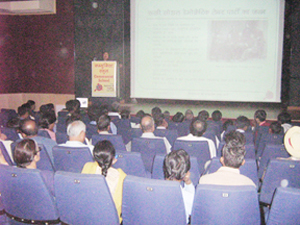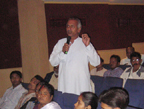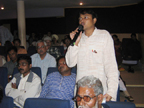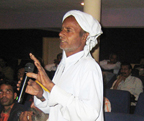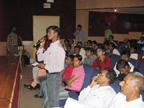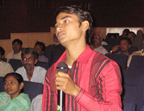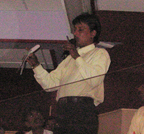
Archive 2009
|
November 16 - 30, December 1-15, 2006 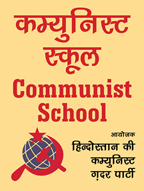 Two-Day Communist School in Delhi: Two-Day Communist School in Delhi:
Magnificent Beginning to the 90 th year since the October Revolution Over 300 communists and activists participated in a two-day Communist School organized by the Communist Ghadar Party of India in November 2006. This Communist School was organised in response to the overwhelming interest among the working class and people, especially the youth, to find an alternative to the existing economic and political system in India. It was organised to strengthen the theoretical and ideological training of revolutionary activists.
The focus of study and discussion during the two days was on the scientific theory of proletarian political power – the theory that will enable the working class to become the ruling class. There were five classes over two days of the School. These related to: (i) the Paris Commune; (ii) the Great October Revolution and the rise and fall of the Soviet Union; (iii) the Chinese Revolution and the capitalist course of present day China; (iv) revolution and counter-revolution in Albania; and (v) direct democracy versus representative democracy. The participants came from all parts of the country, including the south, west, north, east and northeast, as well as from Britain, Canada and the United States. They included activists engaged in organising workers and peasants. They included activists of the women’s movement. There were leaders of youth and students among the participants. There were activists and leading personalities from national liberation movements and the movement for human rights in the Northeast. Comrade Lal Singh inaugurated the event by welcoming all the participants. He pointed out that in our party, the basic organisation is the school of communism, where comrades are receiving communist education all the time. The significance of this event is that we have entered the 90th year since the Great October Revolution. Today we will study the experience of all revolutions where communists have provided leadership, beginning with the experience of the Paris Commune. Comrade Lal Singh pointed out that the Indian revolution is marking time. Indian communists are divided into so many parties and groups, with each claiming that it alone was correct, and refusing to even accept anyone else as communist. It is the tragedy of our country that even with so many communists, revolution has not taken place. Ever since the division of the CPI and formation of CPI(M), so many splits have taken place and so many parties and groups have been formed. They all say they are for revolution, but they are not willing to march forward together. In various parties, the leadership consciously tries to prevent the members from even attending meetings of other communist parties. Comrade Lal Singh emphasized that the CGPI has never followed this path. We tell our comrades to go everywhere, listen to what others have to say, and put forward one’s own views boldly in front of all. We prepare workers and peasants for the revolution, and we are confident that when the time comes, all revolutionary communists will militate in one communist party. We want open discussion amongst communists on how to emerge from the stagnation in the communist movement. We have to have large hearted, and open our hearts and minds to discussion. We have to eradicate this disease wherein everyone wants their view to be heard, but is not prepared to hear others' views, he stressed. Comrade Lal Singh pointed out that Indian revolution has been divided on whether to follow the Russian path, the Chinese path, and so on. If we want to organize Indian revolution, we must defend and develop Indian revolutionary theory, the theory that will guide workers and peasants of our country in the revolution. We must learn from the experience of all great revolutions, but the bottom line is that the Indian revolution must be guided by Indian revolutionary theory. He called upon all the communists participating in the School to contribute in the coming year to the development of Indian revolutionary theory. Each of us is a student as well as a teacher. There is no divide between those who teach and those who learn. This was highlighted by Comrade Lal Singh in his opening remarks. It was evident in the way the school was conducted. Following each class, Comrade Lal Singh, together with the faculty of that class, engaged all the participants in discussion. There were numerous interventions during the discussion, including both requests for clarifications on the presentations and elaborations on the presentations. The discussion was extremely lively and reflected the high level of seriousness and consciousness amongst the participants.The comrades who sat in the podium – that is, the Presidium – spent much more time listening to others than they did in giving lectures.This was a striking feature that many participants noted and appreciated during the discussion. In his concluding remarks, Comrade Lal Singh said “Indian revolution will certainly take place. But this requires a lot of serious work on our part. We must all pledge that we will have similar study and discussion sessions for a whole year beginning now, till the end of 2007. These schools are not meant only for members of the Communist Ghadar Party of India. We should run the school in such a manner that all communists can participate, irrespective of which party they belong to or whether they uphold Lenin or Mao Zedong or someone else. We must conduct the school in such a manner that it is open to those engaged in the struggle and seeking unity of communists”. He announced that similar events will be held in different parts of India during the coming 12 months, organised by the communists in each region. The two-day Communist School, held in Delhi in November, concluded in an atmosphere of revolutionary optimism. Revolutionary songs were sung in several different languages, to resounding applause. The event ended with all participants standing with their clenched fists held high, and singing the Internationale, the song of the international working class. |
